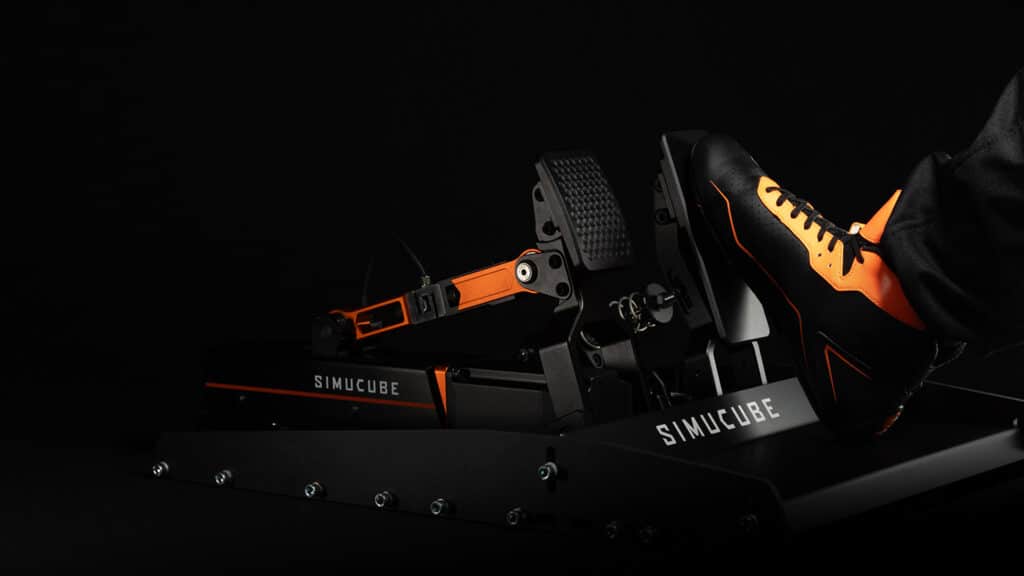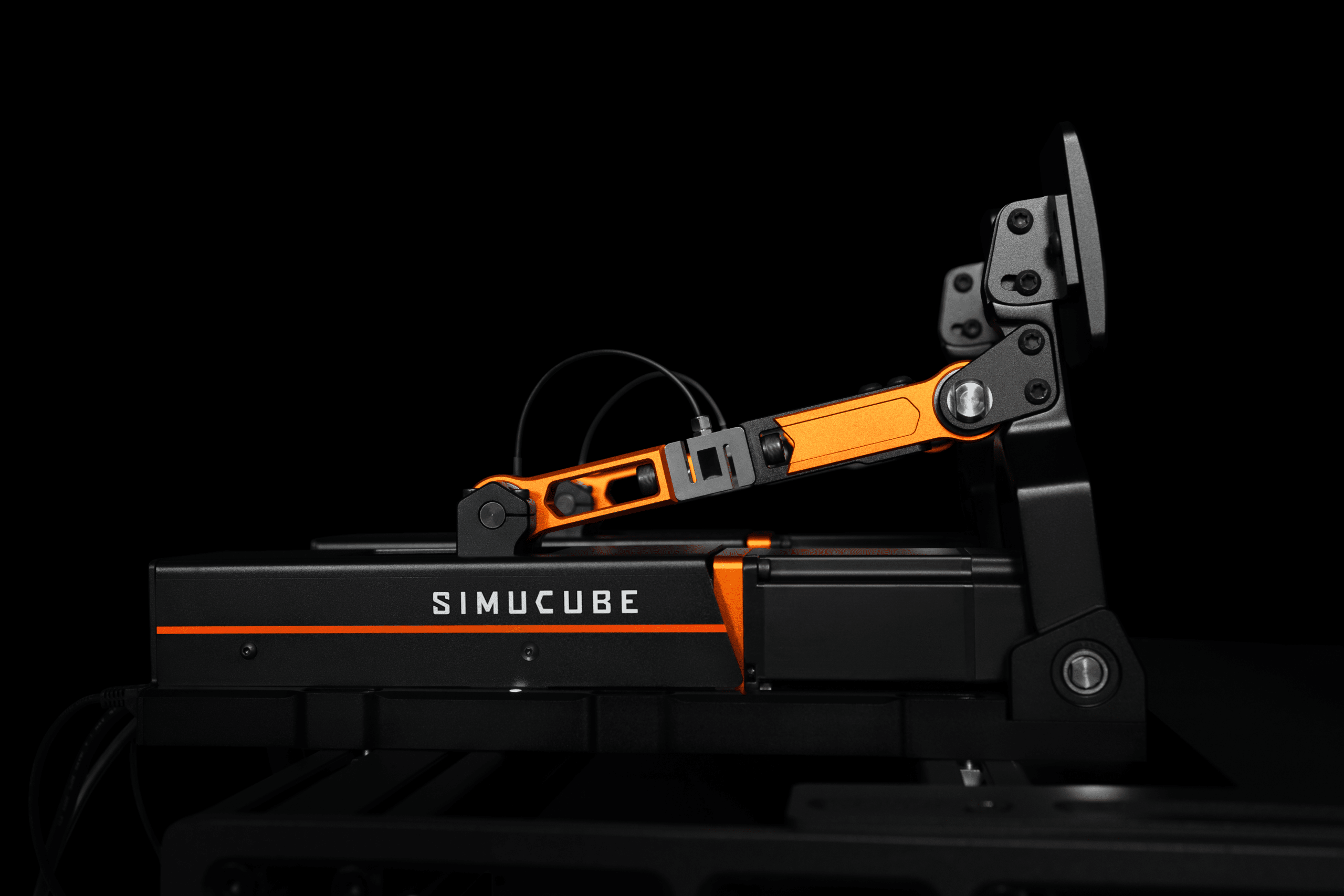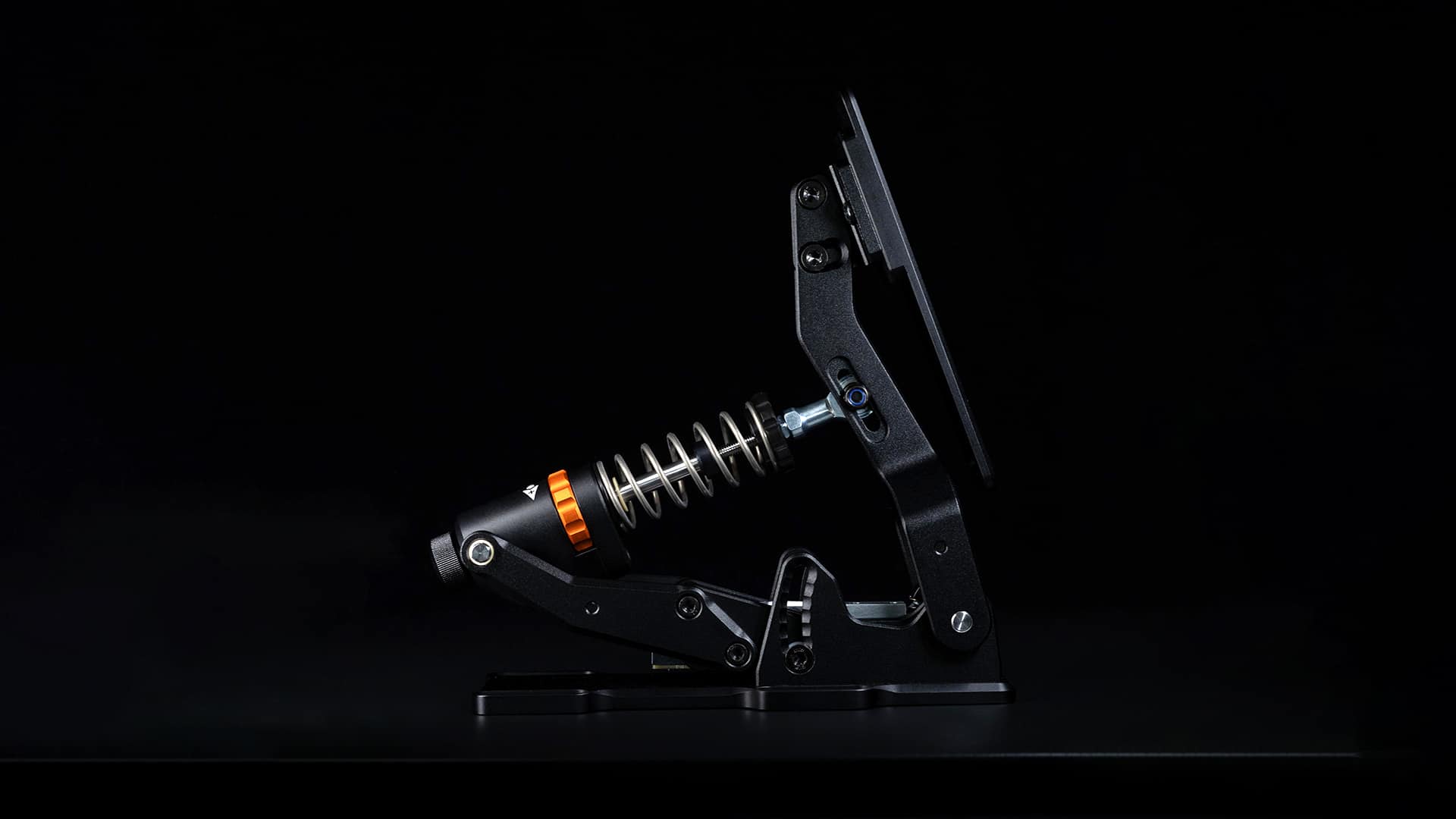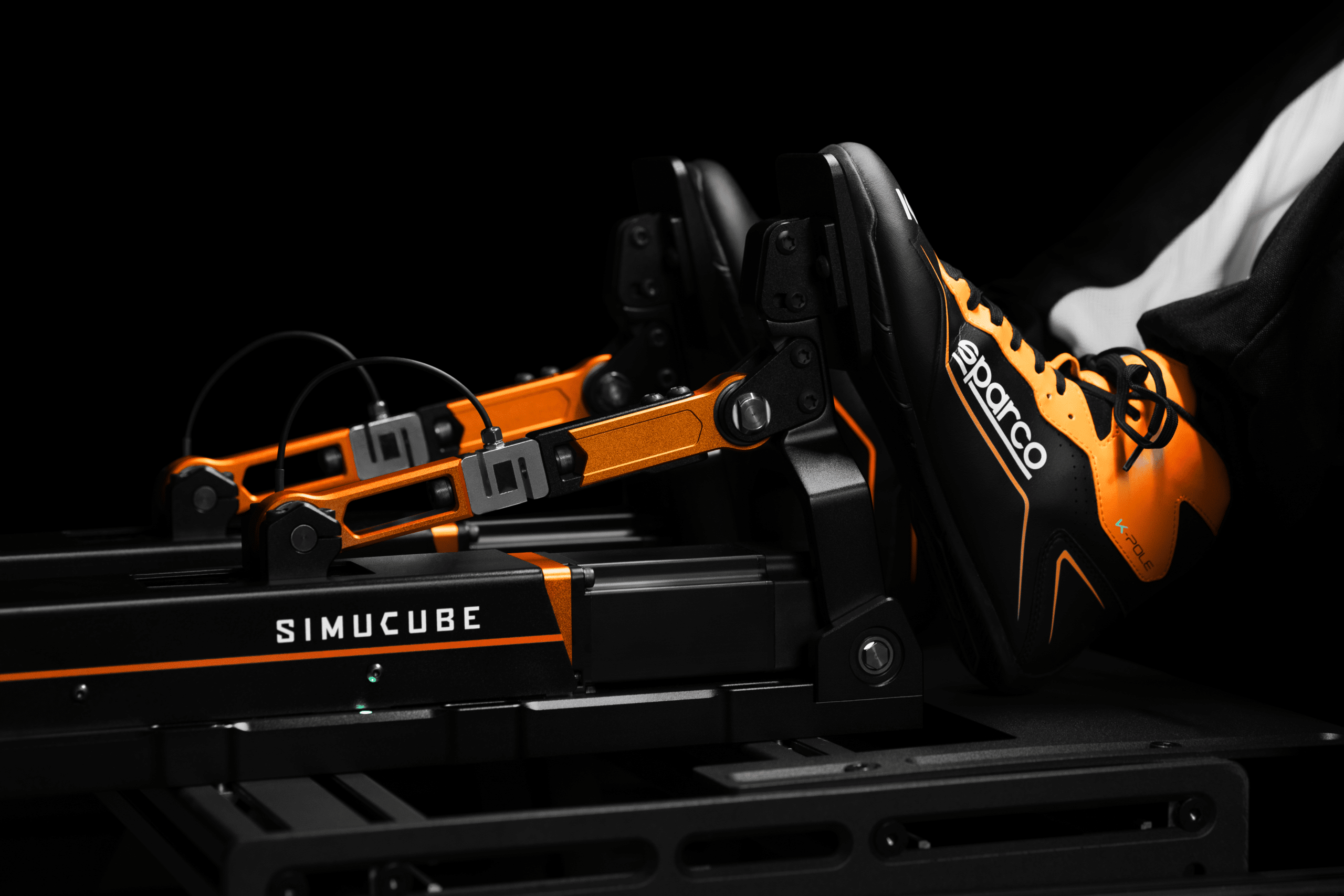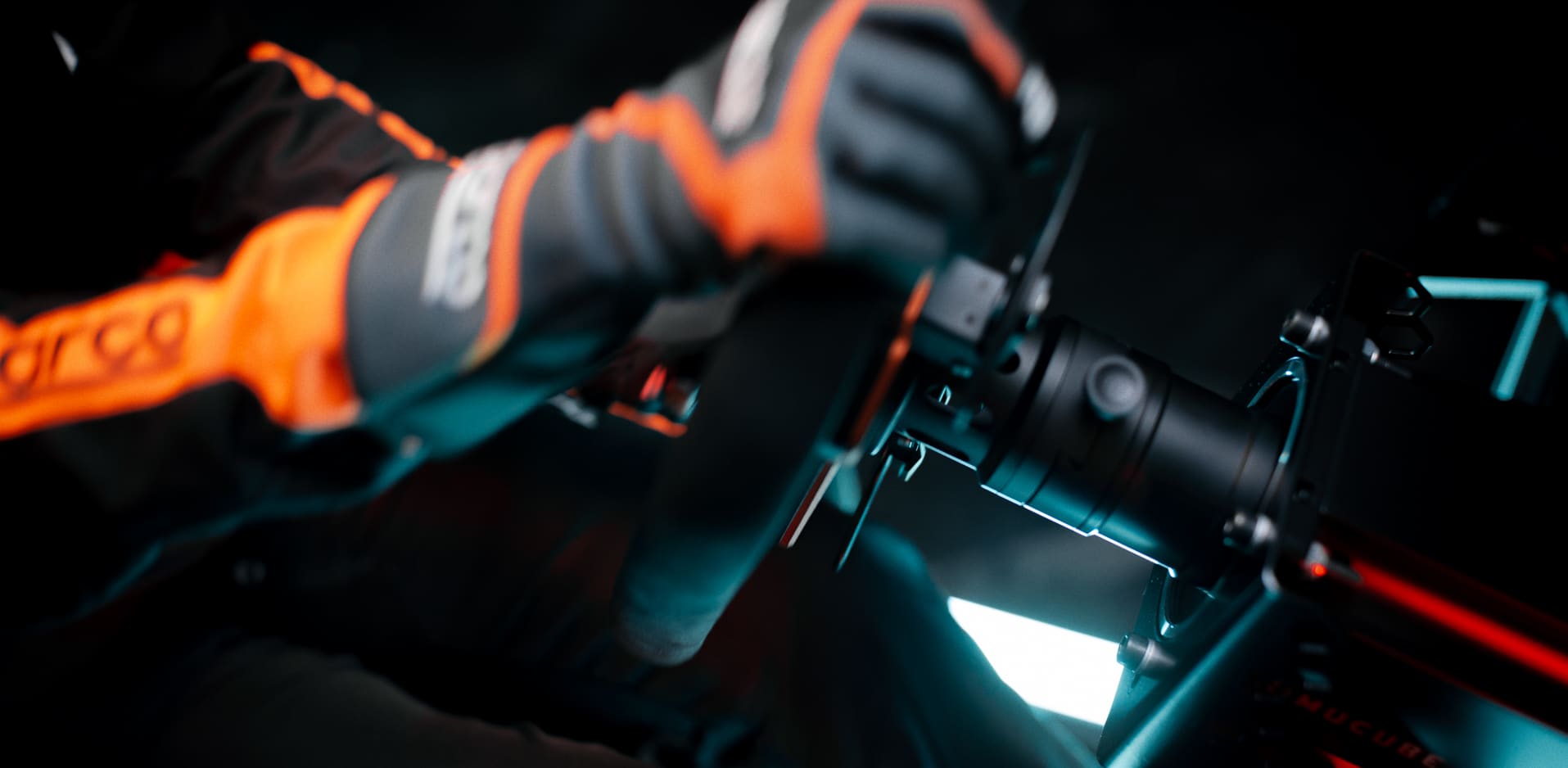A buyer’s guide to high-end sim racing pedals
In this guide, we will focus on explaining the importance of the sim racing pedals when racing, show the differences between an active and passive sim racing pedal, and offer insight into the world of high-end sim racing pedal products.
Why to upgrade to high-end pedals?
Sim racing pedals are the key component in achieving balanced fast cornering and the sensation of being on a real racetrack. If you are struggling with achieving this, high-end sim racing pedals can elevate your brake and throttle balance, and with proper training and changes improve your lap times.
When considering purchasing sim racing pedals, you don’t necessarily need to focus on one specific driving series you enjoy driving, because with a good pedal set, you can adjust the pedal feel to your liking for F1, GT, Rally, LMP, Drifting, and other different race cars and series.
What is the definition of a high-end pedal?
High-end sim racing pedals can be defined through:
- Quality
- Materials
- Design
- Adaptability
- Style, and
- Expected service age
High-end sim racing pedals are made with high quality materials, and they don’t have any short cuts in their design. They are boosting your experience, helping you to elevate your lap times and braking experience.
High-end racing pedals need to be suitable for the driver, and they can’t feel like they are going to break in harder use when racing. Because of the quality materials and design, high-end sim racing pedals should be the only pedals you will ever need.
High-end sim racing pedals provide you plenty of additional features and sensations in relation to reliability and peace of mind. You don’t need to worry that your sim racing pedals would break in a curve, when pushing the pedal.
With the high-end sim racing pedals, you can fully focus on the race and trust that you are getting the best immersive user experience during the race – experience being one with the car on the virtual racetrack.
Different types of high-end pedals
| Passive pedals | Simucube ActivePedal | Hydraulic Pedals | |
| Description | Simple mechanical pedals that are mostly limited to one single pedal feel | Use active digital electronics to simulate multiple real pedals feels | Utilize hydraulic fluid as pressure, which then transfers to sensors detecting pedal movement |
| Feedback Type | Spring and elastomer resistance | Motor-driven feedback, simulates force resistance | Fluid resistance |
| Input detection | Load cell sensor | Load cell sensor | Hydraulic sensor |
| Feel customization | Springs
Elastomers Mechanical additions |
100% digital through software | Fluid types, pedal resistance |
| Adjustability | Low | Best | Better |
| Precision | Good | Best | Better |
| Build Quality | Good | Best | Better |
| Realism | Moderate | High | High |
| Price Range | $$ | $$$$ | $$$$ |
| Maintenance need | Moderate | None | Moderate |
| Pros | · Affordable | · Most versatile
· Precise · Immersive |
· Realistic
· Precise |
| Cons | · Less realistic
· Inconsistent · Needs physical tweaking |
· High cost
· Requires power · Long design |
· High cost
· Potential fluid leaks · Consistency relies on wearing physical parts · Maintenance |
Next, we will explore the concepts of active and passive sim racing pedals and discuss the key differences between these categories. We will also provide examples of what makes a pedal to be a high-end product in its category. Lastly, we will focus on explaining the compatibility matters user you need to think about before purchasing.
Active sim racing pedals
Active sim racing pedals are quite a new pedal category, introduced by Simucube in 2022. Before this, the word active pedal was not yet known in the sim racing market.
When Simucube launched their active sim racing pedal, they also created a new product segment in the sim racing industry and expanded the sim racing pedal concept. They are generally recognized as the future of sim racing pedals and get frequently new features through software.
The Direct Drive of sim racing pedals
Active sim racing pedal has no passive elements and it has been created electrically with servo motor. This means that active sim racing pedal has no springs, fluids, or rubbers. This can be compared to the change when Direct Drive motors replaced belt-driven and gear driven wheelbases some years back.
Upgrade to any pedal you want
Active sim racing pedals have unlimited adjustability and repeatability, you can add a new dimension to your sim racing rig and can also create the feel of the pedal just how you like:
- Adjust to use as a brake, clutch, or throttle
- Take a baseline profile and enhance it with your own liking
- Match specific race car pedals
- Set competitive threshold adjustments to trigger at certain pedal travel
- Share pedal profiles together with other people
Effects that you have not experienced before
An active sim racing pedal, like Simucube ActivePedal, offers various effects designed to give you additional immersion, alongside the wheelbase, giving feedback through ABS, traction control, RPM, G-force, force feedback, and many more.
These effects are meant to simulate the experience of driving a real race car on track, providing a sense of how the car behaves and how the driver’s actions affect its performance. These effects can be modified, adjusted or even toggled-off to match your preferences.
Easy to use software controls the pedals completely
Active sim racing pedals are easy to install and adjust. There is no need to adjust the pedals physically after the initial installation, because all the adjustments can be done easily with software connected to the pedals. This guarantees a carefree racing experience and makes it easy to jump from one race car to another, or upgrade to other pedals, in seconds.
Passive sim racing pedals
Passive sim racing pedals are more traditional option in the pedal market. Their function is based on spring, load cell sensor, and elastomer. With passive sim racing pedals, you need to manually make the wanted adjustments directly on the pedal itself.
Mechanics and haptic additions control the feel
Passive sim racing pedals are designed to emulate the sensation of authentic car pedals through the utilization of mechanical springs, lubricants, and bushings. There are also passive pedals with rumble motor providing haptic feedback. With these types of sim racing pedals, the rumble motor is typically integrated into the pedal’s structure.
When the rumble motor is activated during braking, it generates vibration or shaking, simulating the sensation of braking in a real car. It is designed to add tactile feedback and bring the user more immersive experience.
High-end, as easy as possible, manual adjustments
The features that make passive sim racing pedal high-end are related to ease of adjustments, quality of materials, and resistance. The pedal needs to be designed so that the user can adjust the pedal quickly and simply. Adjusting the pedal cannot compromise the pedal’s durability or quality.
Simucube Throttle is an example of passive sim racing pedal. It is designed to be used alongside the Simucube ActivePedal. It opens the ActivePedal experience for people, who don’t want to buy two ActivePedals, and still want to have a high-end throttle.
It also offers flexibility since you can choose the pedal set you feel is the most beneficial for you.
Sim racing pedals’ compatibility
There are several things regarding compatibility that would be good to check before making the purchase.
These include:
- compatibility with physical sim racing rigs and pedals
- compatibility between the products you already have and the pedals you are going to purchase
- support for effects in games
Next, we will dive deeper into these matters.
Physical compatibility between sim racing rig and pedals
The main thing is to ensure that the pedals could be installed to the rig, so the mounting hole dimensions of the pedals and the rig should match with each other. Usually, rig compatibility information, like the mounting hole dimensions, are listed on the rig manufacturers’ website, and you can also find the product information from the product manufacturer’s website.
For example, Simucube ActivePedal can be installed to almost any Trak Racer and Sim-Lab sim racing rigs, and you can see the mounting hole dimensions from the product website.
If there’s some problems with the hole dimensions not matching each other, additional sim racing rig accessories could help.
For example, Simucube Baseplate is designed to ensure that Simucube pedals can be installed to almost any rig. Otherwise, sim racing pedal baseplate can help you to adjust your legs to the correct height, so that they feel supported.
Compatibility with other products – look out for the vendor-lock
It is important to check the compatibility information with products that you might already have with the sim racing pedals you intend to purchase.
It is worth noting that some large sim racing manufacturers provide products that only work within their brand ecosystem. While this vendor lock makes product choices simpler by limiting the options to one manufacturer, at Simucube we believe the racer should be able to choose whichever product they prefer from each category. The freedom of choice among racers compels us at Simucube to strive even harder in delivering products that truly align with what the customer desires to choose.
As an example, Simucube Link Hub is a way to connect Simucube products with any other ecosystem. Simucube Link Hub connects Simucube Active Pedals to users PC, so Simucube’s sim racing pedals can be used with other brands’ products too – the ones that you choose.
Game and system support
In terms of support for active pedals’ effects in games, you should be aware of that certain games may not support specific effects, such as ABS or traction control. To ensure that your preferred game supports the active sim racing pedals you intend to buy, you should check the information provided by the manufacturer or the game provider.
For example, Simucube ActivePedal page shows that which games support all the effects of the pedals, and which do not.
Conclusion: How to choose your high-end pedals?
High-end sim racing gear is always an investment, but it usually pays off with reliability, ease of use and adjustments, immersive experience and getting the feel like you are in an actual race car.
Commonly, it is more reasonable to buy good high-end products that last than to make interim upgrades and always have the need to upgrade your products again and again. That’s something we hear long-time sim racing hobbyists regretting.
With the right products, your sim racing experience can be leveled up, especially mastering braking with higher end sim racing pedals can make a big difference to your lap times. There are of course several things that need to be considered when trying to decide between sim racing pedal products, and we have tried to list all the important things here in this guide.
Testing high-end sim racing products before making a purchasing decision is a great way to ensure that the pedals suit your needs. There are several places where you can try Simucube products, so that you know that you are making the right decision.
Explore more content
Remember to check out our other buyer’s guide blogs, if you are looking for new sim racing gear.
- A buyer’s guide to high-end sim racing wheelbases
- A buyer’s guide to high-end GT steering wheels
- A buyer’s guide to high-end rally and drifting steering wheels

